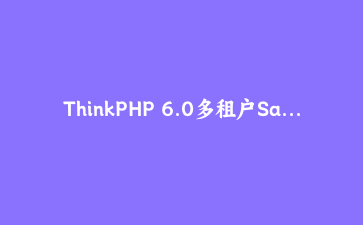前言
ThinkPHP是一款优秀的国产PHP开发框架,以其简洁的语法和强大的功能受到广大开发者的喜爱。本教程将通过一个完整的博客系统案例,带你从零开始学习ThinkPHP的核心概念和开发技巧。
环境准备与项目搭建
首先确保你的系统已安装PHP(7.1+)和Composer。然后通过以下命令创建ThinkPHP项目:
composer create-project topthink/think blog
cd blog数据库设计与配置
我们的博客系统需要三张核心表:
- 文章表(posts):存储博客文章
- 分类表(categories):文章分类
- 评论表(comments):文章评论
在config/database.php中配置数据库连接信息:
return [
'hostname' => '127.0.0.1',
'database' => 'blog',
'username' => 'root',
'password' => 'your_password',
];创建模型
使用ThinkPHP的命令行工具快速创建模型:
php think make:model appmodelPost
php think make:model appmodelCategory
php think make:model appmodelComment定义Post模型关联关系:
namespace appmodel;
use thinkModel;
class Post extends Model
{
// 定义与分类的关联
public function category()
{
return $this->belongsTo(Category::class);
}
// 定义与评论的关联
public function comments()
{
return $this->hasMany(Comment::class);
}
}控制器开发
创建文章控制器:
php think make:controller appcontrollerPost实现文章列表和详情方法:
namespace appcontroller;
use appmodelPost as PostModel;
use thinkfacadeView;
class Post
{
// 文章列表
public function index()
{
$posts = PostModel::with('category')
->where('status', 1)
->order('create_time', 'desc')
->paginate(10);
return View::fetch('index', ['posts' => $posts]);
}
// 文章详情
public function detail($id)
{
$post = PostModel::with(['category', 'comments'])
->where('id', $id)
->where('status', 1)
->find();
if (!$post) {
return '文章不存在';
}
// 增加阅读量
$post->setInc('views');
return View::fetch('detail', ['post' => $post]);
}
}视图模板开发
创建视图文件view/index.html:
<!DOCTYPE html>
<html>
<head>
<title>博客首页</title>
</head>
<body>
<h1>博客文章列表</h1>
{volist name="posts" id="post"}
<article>
<h2><a href="{:url('post/detail', ['id' => $post.id])}" rel="external nofollow" >{$post.title}</a></h2>
<p>分类:{$post.category.name} | 发布时间:{$post.create_time}</p>
<p>{$post.description}</p>
</article>
{/volist}
{$posts|raw}
</body>
</html>路由配置
在route/app.php中定义路由:
use thinkfacadeRoute;
Route::get('posts', 'post/index');
Route::get('post/:id', 'post/detail');实现文章评论功能
扩展Post控制器的detail方法处理评论提交:
public function detail($id)
{
$post = PostModel::with(['category', 'comments'] => function($query) {
$query->where('status', 1)->order('create_time', 'desc');
})->where('id', $id)->where('status', 1)->find();
if (request()->isPost()) {
$data = request()->post();
$validate = new appvalidateComment();
if (!$validate->check($data)) {
$this->error($validate->getError());
}
$comment = new appmodelComment();
$comment->save([
'post_id' => $id,
'author' => $data['author'],
'content' => $data['content'],
'ip' => request()->ip(),
]);
$this->success('评论成功');
}
return View::fetch('detail', ['post' => $post]);
}后台管理功能
使用ThinkPHP的中间件实现后台权限验证:
namespace appadmincontroller;
use thinkfacadeView;
use appmodelPost;
use thinkfacadeRequest;
class Article extends Base
{
public function index()
{
$posts = Post::with('category')
->order('create_time', 'desc')
->paginate(15);
View::assign('posts', $posts);
return View::fetch();
}
public function edit($id = 0)
{
if (Request::isPost()) {
$data = Request::post();
$validate = new appvalidatePost();
if (!$validate->check($data)) {
$this->error($validate->getError());
}
if ($id) {
$post = Post::find($id);
$post->save($data);
} else {
$post = new Post($data);
$post->save();
}
$this->success('操作成功', url('admin/article/index'));
}
if ($id) {
$post = Post::find($id);
View::assign('post', $post);
}
$categories = appmodelCategory::select();
View::assign('categories', $categories);
return View::fetch();
}
}项目优化与部署
1. 开启路由缓存提升性能:
// 应用调试模式
'app_debug' => false,
// 开启路由缓存
'route_check_cache' => true,2. 使用Redis缓存热门文章:
public function getHotPosts($limit = 5)
{
$cacheKey = 'hot_posts';
$posts = cache($cacheKey);
if (!$posts) {
$posts = Post::where('status', 1)
->order('views', 'desc')
->limit($limit)
->select()
->toArray();
cache($cacheKey, $posts, 3600); // 缓存1小时
}
return $posts;
}总结
通过本教程,我们完成了一个功能完整的博客系统,涵盖了ThinkPHP的核心功能:模型关联、控制器、视图模板、路由配置、表单验证和缓存优化。这个项目虽然简单,但包含了Web开发中的常见需求,可以作为学习ThinkPHP的入门项目。
ThinkPHP框架提供了丰富的功能和灵活的扩展机制,适合开发各种规模的Web应用。希望本教程能帮助你快速上手ThinkPHP开发,为更复杂的项目打下坚实基础。















